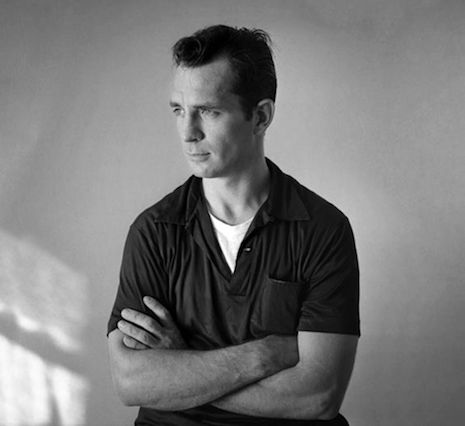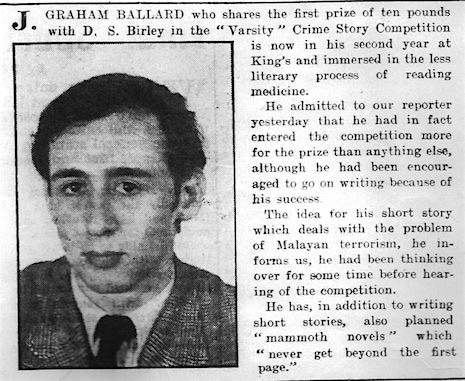
A Burroughsian post for you all on the 102nd anniversary of William S. Burroughs’ birth…
“A Different Kind of Tension,” the antepenultimate song on the Buzzcocks’ album of the same name , can be hilarious or punishing, depending on the circumstances. Pete Shelley’s lyrics are a series of contradictory commands that alternate between your stereo speakers, coming faster and faster with each verse, and pretty soon, Shelley is simultaneously shouting “live” in your left ear and “die” in your right. On a lazy afternoon, it’s enough to make peach Cisco squirt from your nose, but in bumper-to-bumper traffic, you’re liable to start looking around for the Budd Dwyer exit.
, can be hilarious or punishing, depending on the circumstances. Pete Shelley’s lyrics are a series of contradictory commands that alternate between your stereo speakers, coming faster and faster with each verse, and pretty soon, Shelley is simultaneously shouting “live” in your left ear and “die” in your right. On a lazy afternoon, it’s enough to make peach Cisco squirt from your nose, but in bumper-to-bumper traffic, you’re liable to start looking around for the Budd Dwyer exit.

Wikipedia claims that the song quotes William S. Burroughs, but that’s not quite right: it’s more a rewrite of Burroughs’ text than a quotation. Shelley, after all, is credited as the sole author of “A Different Kind of Tension,” whose lyrics are printed in parallel columns on the record’s three-color sleeve:
Wait here - Go there
Come in - Stay out
Be yourself - Be someone else
Obey the law - Break the law
Be ambitious - Be modest
Plan ahead - Be spontaneous
Decide for yourself - Listen to others
Save money - Spend money
Be good - Be evil
Be wise - Be foolish
Be safe - Be dangerous
Be satisfied - Be envious
Be honest - Be deceitful
Be faithful - Be perfidious
Be sane - Be mad
Be strong - Be weak
Be enigmatic - Be plain
Be aggressive - Be peaceful
Be brave - Be timid
Be humane - Be cruel
Be critical - Be appreciative
Be temperamental - Calm
Be sad - Be happy
Be normal - Be unusual
Stop - Go
Live - Die
Yes - No
Rebel - Submit
Right - Wrong
Sit down - Stand up
Create - Destroy
Accept - Reject
Talk - Silence
Speed up - Slow down
This way - That way
Right - Left
Present - Absent
Open - Closed
Entrance - Exit
Believe - Doubt
Truth - Lies
Escape - Meet
Love - Hate
Thank you - Flunk [actually “Fuck you”]
Clarify - Pollute
Simple - Complex
Nothing - Something
Stop - Go
Live - Die
Yes - No
Rebel - Submit
Right - Wrong
Sit down - Stand up
Create - Destroy
Accept - Reject
Talk - Silence

A 1969 review of The Mind Parasites by William “Borroughs” (larger)
The Buzzcocks had a thing for magazine reviews; they took their name from the last line of a review of the TV series Rock Follies (“Get a buzz, cock”), and, if memory serves, the phrase “a different kind of tension” itself comes from Jon Savage’s review of Love Bites in Sounds. For the sake of consistency, I’d like to think Shelley spotted Burroughs’ list of incompatible injunctions in the author’s 1969 review of Colin Wilson’s The Mind Parasites , which first ran in a New York underground newspaper called Rat and was reprinted that year in John Keel’s Anomaly. But Shelley is just as likely to have encountered Burroughs’ list in the CONTROL section of 1974’s The Job
, which first ran in a New York underground newspaper called Rat and was reprinted that year in John Keel’s Anomaly. But Shelley is just as likely to have encountered Burroughs’ list in the CONTROL section of 1974’s The Job , or some other place Burroughs might have recontextualized these do’s and don’ts:
, or some other place Burroughs might have recontextualized these do’s and don’ts:
Stop. Go. Wait here. Go there. Come in. Stay out. Be a man. Be a woman. Be white. Be black. Live. Die. Yes. No. Do it now. Do it later. Be your real self. Be somebody else. Fight. Submit. Right. Wrong. Make a splendid impression. Make an awful impression. Sit down. Stand up. Take your hat off. Put your hat on. Create. Destroy. React. Ignore. Live now. Live in the past. Live in the future. Be ambitious. Be modest. Accept. Reject. Do more. Do less. Plan ahead. Be spontaneous. Decide for yourself. Listen to others. Talk. Be silent. Save money. Spend money. Speed up. Slow down. This way. That way. Right. Left. Present. Absent. Open. Closed. Up. Down. Enter. Exit. In. Out.

This isn’t quite “Choose life” from Trainspotting, if that’s what you’re thinking. Far from complaining about the modern world’s banality like Steve Martin’s Beat poet on Saturday Night Live (“Oh, Mr. Commuter! / Wash me not in your Mad Ave. paint-by-numbers soap…”), Burroughs was giving his readers detailed instructions in piercing the tedium of everyday life with “a technique for producing events and directing thought on a mass scale [that] is available to anyone with a portable tape recorder.” Burroughs goes on to explain in his Mind Parasites review how the “waking suggestion” technique of Dr. John Dent, whose apomorphine cure for heroin addiction he advocated, can be used for mind control:
These commands are constantly being imposed by the environment of modern life. If the suggestion tape contains the right phraseology, and listeners hear it in the right situation (while doing something else), they will be forced to obey the suggestion. It is like giving someone a sleeping pill, without his knowledge, and then suggesting sleep.
At the unconscious level, any contradictory suggestion produces a brief moment of disorientation, during which the suggestions take place. This is important to remember because this is something you can – in a pinch – employ yourself. (Con artists, spies, military strategists, and social climbers use such diversions to their advantage. Why can’t you?)
This moment of disorientation is not unknown to the human body, because contradictory suggestions are an integral function of human metabolism: “Sweat. Stop sweating. Salivate. Stop salivating. Pour adrenaline into the bloodstream. Counteract adrenaline with epinephrine.”
Since contradictory commands are enforced by the environment and the human body, contradictory commands are especially effective. All tape recording tricks are useful: speed up, slow down, overlay, run contradictory commands simultaneously, add superfluous “echo” recordings for large spaces, etc.
Continues after the jump…





































